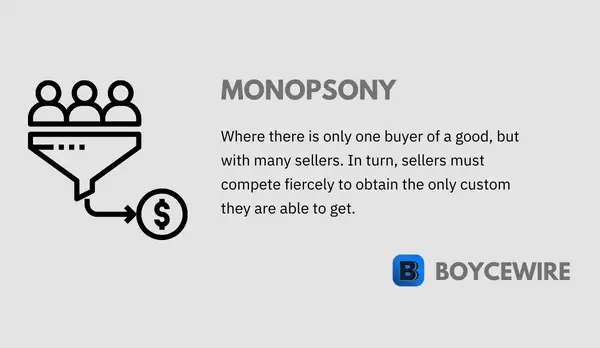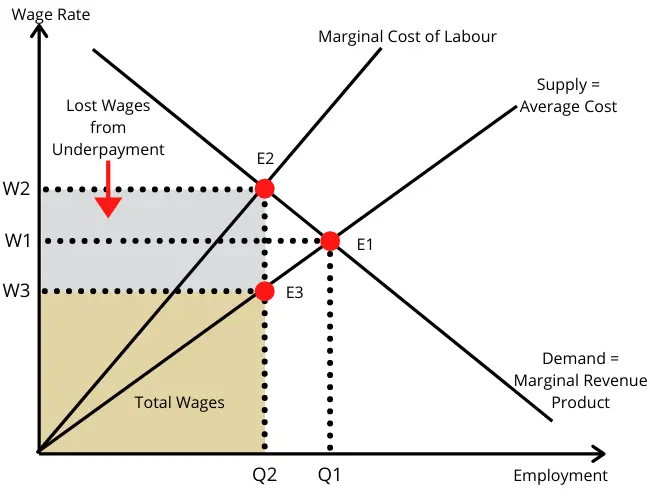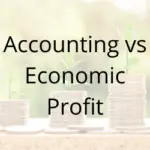Monopsony: Definition, Examples & Characteristics

What is a Monopsony
A monopsony is where there is a sole buyer of a product, with many sellers. For example, supermarkets are often seen to have a monopsony over local suppliers. Farmers may only have the option to sell to the local supermarket as it’s unpractical to sell to the next closest one. In turn, the buyer, the supermarket, is able to exert power over such suppliers who have nowhere else to go. This contrasts with the similarly named monopoly, whereby there is only one seller and many buyers.
The term ‘monopsony’ is of Greek origin and comes in two parts. The first of which is the term ‘Mono’, meaning ‘one’. We then have the second part, the word ‘opsōnéō’, which means ‘to buy’. In turn, these two terms create the word ‘monopsony’ which simply means one buyer.
A monopsony is where there is only one buyer of a good. For example, a small town may have a large manufacturer that it relies on for employment. However, the people of the town have no other option than to work for the company if they want an income. A monopsony doesn’t just refer to the purchase of goods, but also services such as labour. Quite simply, it is an economic transaction where there is only one buyer, but many sellers.
Key Points
- A monopsony is where there is only one buyer of a good or service.
- Examples of monopsony’s are generally in the labour market – where there is one company with many workers that want to sell their labour.
- Firms with monopsony power are able to negotiate lower prices as suppliers are unable to sell their goods elsewhere.
Firms with a monopsony have the power to dictate prices they pay for goods and services. As there are many sellers, the firm can easily go elsewhere, but at the same time, the sellers are reliant on the single firm’s business. So, without the monopsony firm, they would not have a business themselves.
Monopsony vs Monopoly
Monopsony and monopoly are very similar terms so it is easy enough to get them both confused. They both derive from the Greek ‘Mono’, which means ‘one’ or ‘only’. However, that is where the similarities end.
Monopsony refers to the buyer of a good – whereby there is only one, but many sellers. By contrast, a monopoly is where there is only one seller of a good, but many buyers.

A monopsony is the only buyer in the market, so it has the ability to put pressure on the sellers to reduce their prices. As the sellers cannot go anywhere else to sell their goods, the buyer has the ability to go elsewhere if it doesn’t get the price it wants. By contrast, a monopoly is the only seller in the market, so can charge higher prices to the buyer as they are unable to buy from anywhere else.
Monopsony Examples
Firms with a monopsony tend not to exist in the real-world, at least not to its precise definition. Similarly to perfect competition, it doesn’t tend to exist – although there are examples whereby companies exert monopsony like power. Supermarkets for instance tend to have great power over its suppliers – although this is more of an oligopoly structure, with a few buyers instead of a sole buyer.
There are also suppliers to the government, which we can consider as a monopsony. However, this doesn’t fit the definition of a monopsony as there aren’t many sellers in the market. For instance, with regards to fighter jets, there are only 3 companies that serve the US government. So whilst the US government is able to maintain bargaining power, it is unable to exert the same undue influence should there be forty suppliers.
What tends to happen is that the selling companies merge together to increase their negotiating power against the monopsony firm. In fact, we can see this is the case for many labour unions that try to fight firms with monopsony like power.
With that said, let us look at some hypothetical examples.
Example #1
Over 1,000 people live in a small town on the east coast of the US. In that small town, there is a large manufacturing firm that makes motor vehicles. It employs most of the working-age population in the town to work for it.
If any of the people living in the town want another job, they either have to set up a company of their own or leave town to the city. With that in mind, the manufacturer is able to pay lowers wages as the people of the town would prefer to work for a low wage than the other alternatives.
Example #2
There is a small village that has 50 houses for sale at the same time. The village is quite small and the demand to live there isn’t that high. In fact, there is only one person that is looking to buy a house.
That one buyer effectively has monopsony power as there are many options, but there is only one buyer. In turn, the buyer is able to use this differential in negotiating power to lower the price of their preferred house.
Example #3
There is one large supermarket that serves Country A which has a population of 1 million. It requires products such as meats, vegetables, and dry goods. These goods are supplied by over 1,000 individual companies all competing with each other.
The supermarket has the choice of 1,000 suppliers but is the only buyer that those companies can go to. So if the supermarket doesn’t buy from them, they will likely go out of business. This allows the supermarket to extract full profitability from them. So prices can be driven down so that the price they buy will be close to the price it costs to make – leaving the supplier with little if any profit.
Monopsony Graph
When a monopsony firm wants to hire more workers, it has to offer higher wages. However, that not only means higher wages for the marginal workers but also for the existing workers. This is why the marginal cost is sloping higher than the average cost.
As we can see from the graph, E1 represents what would constitute a normal competitive market – where supply and demand intersect. However, the marginal cost to hire more workers is higher than the average cost because the company has to raise the wages of all workers. That brings us to point E2 – where profit maximisation occurs and marginal cost = marginal revenue.

If the firm is looking to maximise profits, it would produce at E2, because the price to make one good is equal to the amount it earns. So at any point after this, it would then make a loss. However, at E2, the wage is W2 – significantly higher than those workers would be willing to accept. At the same time, the demand for the workers from the firm decreases as they become more expensive.
So instead of paying the employees W2, the monopsony firm is able to pay them at W3, which is significantly less. This then takes us to E3 on the graph – which refers to how much the monopsony firm pays its staff and the quantity of staff it gets for these. What results is lower levels of employment and lower wages for the workers.
Monopsony Characteristics
1. Market Power over Suppliers
As suppliers have little or no alternatives, they have to sell to the buyer even if that means low or little profitability. The monopsony firm is able to dictate terms to its suppliers as it can simply say that it will go to another supplier if its terms are not met.
2. Lower Wages
When a monopsony has power over labour, it is able to extract lower wages. This is more likely in small towns and labour markets as there are often many other firms that workers could choose from. Its power is enhanced when the alternative options are small – such as a local town. However, in a larger town with more firms, there is not the same monopsony power as workers can choose to work at other firms.
3. Lower Employment
Lower wages mean some workers will simply not work for that salary, meaning either they move location or do not work. As monopsony power can seem abusive, many workers may become disgruntled and dissatisfied with their job and leave the market entirely.
4. Many Suppliers
In order for the buyer to assert power over suppliers, it must have a large choice to choose from. As there is a high level of competition among suppliers, prices are driven down as they need the custom from the buyer to stay in business.
5. High Profit Margins
As the monopsony firm has power over suppliers, it can reduce its costs. In turn, this allows it to make higher profit margins when it sells to the consumer.
FAQs on Monopsony
The closest you might get to a real-life monopsony is the supermarket retailers. There is more than one buyer of the good, but there are still thousands of farmers and other suppliers. Firms such as Walmart are able to negotiate in a similar fashion to a firm that has monopsony power. The main difference is that there are a few, if only a limited amount of buyers – which means it cannot classify as a monopsony. However, it is a close example.
The main difference between a monopoly and monopsony is the fact that a monopoly is where there is only one seller, whilst a monopsony is where there is only one buyer.
Monopsony’s can create negative effects such as forcing workers and suppliers to accept a lower wage. In turn, this not only affects the money their suppliers could receive, but also the number available. Many business will be unable to continue under these price pressures. At the same time, there are fewer employees as there will still be some that are unwilling to work at a lower wage. So there are fewer suppliers and fewer employees in the market.
About Paul
Paul Boyce is an economics editor with over 10 years experience in the industry. Currently working as a consultant within the financial services sector, Paul is the CEO and chief editor of BoyceWire. He has written publications for FEE, the Mises Institute, and many others.

Further Reading
 Accounting vs Economic Profit - The main difference between accounting and economic profit is that economic profit includes implicit costs. Whilst accounting profits include the…
Accounting vs Economic Profit - The main difference between accounting and economic profit is that economic profit includes implicit costs. Whilst accounting profits include the…  Bull Market - A bull market is a financial market where prices of securities are generally rising, indicating positive investor sentiment and a…
Bull Market - A bull market is a financial market where prices of securities are generally rising, indicating positive investor sentiment and a…  Balance Sheet: Definition, Format & Example - The balance sheet is a key financial statement that public and private companies report on. It highlights a firm's assets,…
Balance Sheet: Definition, Format & Example - The balance sheet is a key financial statement that public and private companies report on. It highlights a firm's assets,… 